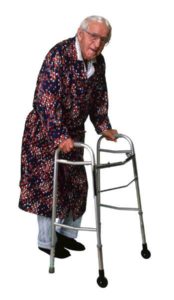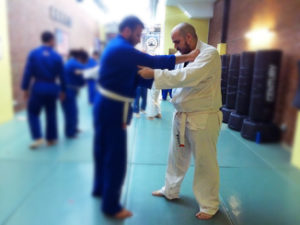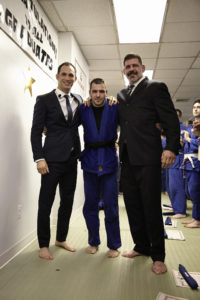A friend of mine, who I haven’t seen in years, contacted me on Facebook. He asked me a question I’ve answered dozens of times as an instructor:
“I’m 40…can I really start training at my age?”
My unqualified response is – of course – yes. It’s never too late.
But there are a few important caveats for anybody who’s beginning (and these aren’t bad reminders for those of us who have been practicing for a while either…)
First, know that starting is usually the easy part. Staying takes work. In fact, it may take your 40 years of living to be able to do it. Now that doesn’t only mean that it’ll be physically demanding all the time, because you’ll have peaks and valleys. But managing the discipline, focus, new choices and thought models always asks something of us.
Next, it’s true that choosing your school can be the most important decision you make. This is true no matter how old or young you are. When it comes to the longevity of your training its important for you to look at the long arc, and the values of your school play a big role here. For someone who’s over 40, a “sport” approach to martial arts that favors athleticism, flexibility or speed might not be the best fit.
By the way, don’t envision yourself as a 40-year-old doing Martial Arts. Instead, try to picture yourself as a 50-year-old doing it. And then as a 60-year-old. Why? Well, this thinking can help you prepare yourself mentally for a marathon rather than a sprint. Lots of the benefits of martial arts training accrue over the years; even if all you want is some self-defense basics, you might find that a few good things done repeatedly over time become great.
And don’t think of yourself like this:

When this is more like what you’re going for:

(You can learn more about getting started right here: starting at Brooklyn Brazilian Jiu-Jitsu)
Now, whether you’re 40 years old or not, if you’re considering martial arts – Jiu-Jitsu or Kickboxing or anything else – there are a few other things that really are worth mentioning:
1. Find a place that isn’t solely committed to training fighters. In fact, if you’ve been reading this blog, you know that we recommend you find a school that isn’t at all into fighting or competition.
2. Watch a class. Pay attention to the pace and the faces of the students. Are they being aggressive and competitive or are they being playful and having a good time? If someone accidentally gets bumped or bruised (it happens from time to time), does his or her partner care? This will give you an indication of the temperament of the school.
3. Meet the instructor. Make sure they’re someone that has time for you. Ask them if they think you’re too old or too out of shape or too whatever. If they do, move on. Someone else will be willing to give you the attention that you deserve.
(And remember that not all black belts are great teachers, and not all great teachers wear a black belt. So you don’t need to obsess about what degree black belt or where it’s from, etc. First find out if they care about safety and about people.)
4. Some practitioners train like they have something to prove, rather than something to improve. Don’t do this. If you’re a younger person, you shouldn’t need to be one-upping your classmates. If you’re an older person, make sure you’re not pulling an “Al Bundy”, trying to relive the glory days of when you were a star athlete in high school.
5. Start slow and pace yourself. You’re excited to learn. And to know more. And to “get good.” But just relax and settle into a rhythm of 2-3 classes a week and you’ll get there faster.
6. Keep in mind, if you are over 40, that there will be a lot of students younger than you…and who will be your “senior” when you’re on the mat together. Give them that respect. Listen to their coaching and their guidance. Chances are, if their instructor has coached them well, they’re probably right.
Fair enough?
(And you can learn more about how we do what we do here.)
If you’ve found the right place for you, you’ll have people you can trust. You’ll be able to assimilate with the culture of the school and you’ll do just fine.
Don’t forget that its important to enjoy your training above all. Not in a short-term, instant-gratification way, but in a deeper, more mature way.
I think you’ll agree with me when I say that it can be incredibly profound and rewarding. It can teach us lessons about life and our relationship with others that are hard to get anywhere else. It can help you get into and stay in the best physical shape of your life.
Earlier I mentioned that starting might seem challenging. So just get it over with. The next, and most important, step is delving deeper into the practice, learning more about yourself and getting fitter as you go.
Good luck! Leave any comments or thoughts below for us.







 If we want to lead a healthy lifestyle, we have to develop healthy habits. And just as with Martial Arts training, there are no shortcuts.
If we want to lead a healthy lifestyle, we have to develop healthy habits. And just as with Martial Arts training, there are no shortcuts.
 The good news for us is martial arts are designed for that slow process of incremental growth. We crawl in the beginning, and then when we can stand on our two feet confidently, we’re invited to reach a little beyond where we are. Maybe not to run, but certainly a brisk walk or a trot. It may mean working with more experienced partners, or it may mean more progressive techniques. It could be moving to a more advanced program of training.
The good news for us is martial arts are designed for that slow process of incremental growth. We crawl in the beginning, and then when we can stand on our two feet confidently, we’re invited to reach a little beyond where we are. Maybe not to run, but certainly a brisk walk or a trot. It may mean working with more experienced partners, or it may mean more progressive techniques. It could be moving to a more advanced program of training.
